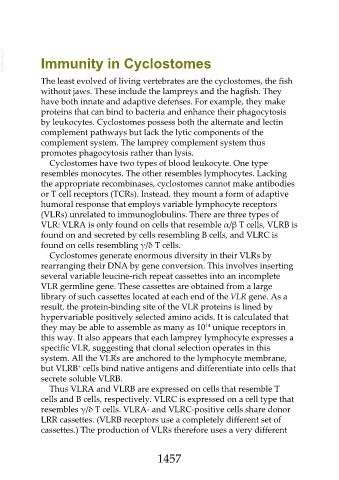Page 1457 - Veterinary Immunology, 10th Edition
P. 1457
VetBooks.ir Immunity in Cyclostomes
The least evolved of living vertebrates are the cyclostomes, the fish
without jaws. These include the lampreys and the hagfish. They
have both innate and adaptive defenses. For example, they make
proteins that can bind to bacteria and enhance their phagocytosis
by leukocytes. Cyclostomes possess both the alternate and lectin
complement pathways but lack the lytic components of the
complement system. The lamprey complement system thus
promotes phagocytosis rather than lysis.
Cyclostomes have two types of blood leukocyte. One type
resembles monocytes. The other resembles lymphocytes. Lacking
the appropriate recombinases, cyclostomes cannot make antibodies
or T cell receptors (TCRs). Instead, they mount a form of adaptive
humoral response that employs variable lymphocyte receptors
(VLRs) unrelated to immunoglobulins. There are three types of
VLR: VLRA is only found on cells that resemble α/β T cells, VLRB is
found on and secreted by cells resembling B cells, and VLRC is
found on cells resembling γ/δ T cells.
Cyclostomes generate enormous diversity in their VLRs by
rearranging their DNA by gene conversion. This involves inserting
several variable leucine-rich repeat cassettes into an incomplete
VLR germline gene. These cassettes are obtained from a large
library of such cassettes located at each end of the VLR gene. As a
result, the protein-binding site of the VLR proteins is lined by
hypervariable positively selected amino acids. It is calculated that
14
they may be able to assemble as many as 10 unique receptors in
this way. It also appears that each lamprey lymphocyte expresses a
specific VLR, suggesting that clonal selection operates in this
system. All the VLRs are anchored to the lymphocyte membrane,
+
but VLRB cells bind native antigens and differentiate into cells that
secrete soluble VLRB.
Thus VLRA and VLRB are expressed on cells that resemble T
cells and B cells, respectively. VLRC is expressed on a cell type that
resembles γ/δ T cells. VLRA- and VLRC-positive cells share donor
LRR cassettes. (VLRB receptors use a completely different set of
cassettes.) The production of VLRs therefore uses a very different
1457

